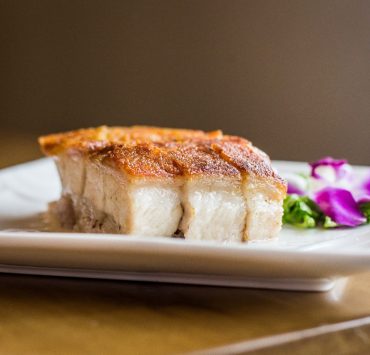Ramon “Richie” Lerma, director of Salcedo Auctions, was told he was inspecting photographs of a boceto of the “Spoliarium”—Juan Luna’s most celebrated, larger-than-life painting currently on display at the National Museum.
A boceto, he explained to reporters, is a “prelude or study,” like a first draft for writers, of what a painter plans to execute later as a larger-scale ouvre. Luna’s award-winning work, measuring roughly 7 by 4 meters, earned him the First Class Medal at the 1884 Expocision Nacional de Bellas Artes in Madrid.
Lerma noticed a detail that made him excited and intrigued. On the lower right corner of the painting was an inscription that says “SPOLIARIVM = boceto” followed by what appears as an upside down heart with a dot under the right curve and a capital T with a wavy tail. Then “LVNA = 1883.”
Finished works, like Luna’s famous painting, are usually signed by the artist. Bocetos, not so. The boceto that the current owner asked Lerma to examine had a signature. Lerma noted the inscription was made in “an unhesitating manner, in flowing penmanship.”
Baybayin glyphs
The two mysterious figures turned out to be glyphs from the ancient baybayin text of pre-Hispanic Filipinos. “A boceto made in Europe but signed in our indigenous script? What is this doing here,” Lerma asked himself.
The curving figures, when translated, mean “BU” and “LA.” “Bulan” is the Ilocano word for “moon.” Luna’s surname is the Spanish word for “moon.” Luna was an Ilocano.
Lerman, erstwhile director of the Ateneo Art Gallery, remembered historian and Inquirer columnist Ambeth Ocampo once saying Luna had at least two other works that carried baybayin glyphs.
(A Luna painting titled “Doña Consolacion, the character from fellow propagandist Jose Rizal’s novel “Noli Me Tangere,” carries the initials JB for “Juan Bulan.”)
“You would need someone who knows baybayin, spoke Ilocano and lived in Europe in the 19th century to be able to write the glyphs. That was very telling to me,” Lerma said.

One of the first things Lerma did upon seeing the boceto was to conduct a UV light test as part of routine scientific exam of an aged artwork.
“When put under the UV light test, this particular (painting) flashes a very serene green glow. The greener the glow, the older the painting. This particular painting had this quality. Most telling is the signature area. When you flash the UV light, the signature is not seen,” he noted.
Why is this relevant? Lerma explained that a signature written on a painting at the time it was completed would disappear under UV light.
“If the signature was added later on, you will see “LUNA” emerging under UV light,” he added.
Historians and art critics have discussed the relevance of the Spoliarium, a graphic and detailed rendition of defeated Roman gladiators that Salcedo Auctions described as “being dragged into the basement of the Roman Coliseum, where they will be stripped of their weapons and armor, flanked by jeering onlookers and leering opportunists angling for spoils.”
Boost to the Propaganda Movement
Rizal, in a toast to the victory of Luna and runner-up Felix Resurreccion Hidalgo for his “Virgenes Chrstianas Expuestas al Populacho” at the Expocision, “would provide a reading of the painting that would indelibly tie the Spoliarium to a nationalist narrative,” the auction house added.
Rizal was quoted saying: “…from it one can hear the tumult of the throng, the cry of slaves, the metallic rattle of the armor on the corpses, the sobs of orphans, the murmurs of prayers, with as much vigor and realism as one may hear the crash of thunder amid the roar of waterfalls or the imposing, irredeemable, and terrible tumble of an earthquake.”
The twin victories of Luna and Hidalgo were an immense boost to the morale of the Propaganda Movement that advocated for reform, not independence from Spain. The propagandists, mostly educated in Europe, demanded better treatment “as an intrinsic part of the Motherland.”
The two paintings that bested Spanish entries were an indication that the sons born in the far-flung archipelago knew their art and used it to intelligently communicate their aspirations to the conquistador.
The auction house director refused to discuss details about the boceto’s current owner for security reasons. He only said the anonymous seller lives somewhere in Europe. It was a “private European collector” who sent detailed photographs of the boceto to Lerma.
His subsequent sleuthing into the work’s authenticity however, offered more surprises.
Like a “low-res” version of Spoliarium
Upon seeing the actual work, Lerma initially thought the boceto’s style “appeared to be very different” from the actual Spoliarium.
A side-by-side comparison of sections of the finished work now at the National Museum with the boceto however, “showed many similarities as well as marked differences, not to mention the addition (or subtraction) of details, the shifting forms…and changes in hues and tones—qualities that can be explained by understanding the nature of the work that was being presented,” Lerma explained.
The boceto for example, is “more impressionistic” than the actual Spoliarium. To the untrained eye, the boceto appears as a low-resolution version of the prize-winning painting. The Spoliarium shows more clearly the sinewy muscles of the fighters as well as the facial expressions of the characters.

The boceto also casts “light” on more figures in the painting, unlike the Spoliarium where the illumination is more focused on the fallen gladiator.
Lerma pointed to an outstanding feature of the boceto. On the right side of the study is a woman in “Aegean blue,” her back turned to the viewer.
He said the same color “will take prominence in (Luna’s) later painting ‘A Do…Va La Nave?’ from 1885. While the blue…is an indication of wealth and privilege, here (in the boceto) it serves as a counterpoint to balance out the heavy activity on the left side of the painting.”
In a news conference held at The Peninsula Manila, Lerma said Luna worked on the award-winning Spoliarium around July 1883 while in Rome. The boceto was completed in March 1884 and was first shown at the Palazzi della Exposione with the King and Queen of Italy attending, on Via Nazionale along with the works of Spanish painters.
The Spoliarium won the grand prize in Madrid in June 1884. In October, Luna and the Spoliarium went to Paris.
Two years later, the same work earned a Third Class Medal when presented to the academic salon of the Societe des Artistes Français. From Paris, it moved to Barcelona where it was displayed at the Sala Parès, attracting 60,000 viewers in two days. The Provincial Government of Barcelona later purchased it for 20,000 pesetas and placed in the city’s Museo de Arte Moderno in 1887.
A gift from Generalissimo Franco
The Spoliarium stayed in storage in Spain until 1958 when the dictator Generalissimo Francisco Franco gifted it to the Philippine government.
Research made by Salcedo Auctions indicated it was cut into three parts “to facilitate its transport halfway across the globe, the mural would then be consolidated and restored before being exhibited at the Hall of flags of the Department of Foreign Affairs in Manila in 1962.”
All this time, Lerma learned the boceto forged a separate path. In his effort to trace the boceto’s provenance, he was surprised to discover that the anonymous owner also kept a painting by Luna’s artistic archrival Felix Resurreccion Hidalgo titled “La Pintura” depicting a female artist holding an easel, her back turned to the viewer.
The current Europe-based owner came from a family based in Sarria, a town in the province of Lugo in Northern Spain. The Luna boceto and the Hidalgo work were previously owned by the Castiñeira family that descended from Don Xosè Vasquez Castiñeira, mayor of Sarria in 1890.
The paintings were handed down to the mayor’s son Don Francisco Vasquez Gayoso, and upon his death, his widow Doña Maria Nuñez Rodriguez.
Being childless, Doña Maria later bequeathed the two paintings to the current owner, Lerma said. Still, the auction house director pressed for details about how the Castiñeira family got the paintings in the first place.
His investigation revealed Don Xosé and his family lived across Don Matias Lopez y Lopez, a businessman-chocolatier who had close ties with Spain’s King Alfonso XII.
In 1889, the Spanish government appointed Lopez as President of the Spanish committee and Commissioner of the Spanish Pavilion of the Universal Exhibition in Paris.
Lerma said his research showed that Luna and Hidalgo’s names appeared in “various annexed documents from newspapers at that time” along with Lopez’s.
“It is not farfetched to conjecture from this close association and circumstantial evidence that Lopez could have directly acquired paintings from both artists,” Lerma theorized.

“Indeed, what other explanation could there be for Luna’s Spoliarium boceto and Hidalgo’s portrait of a female artist to travel 1,500 kilometers from…Paris to the small town of Sarria? Spatially and temporally, the most plausible explanation would be that this exchange and movement happened sometime during or immediately after the Universal Exhibition of 1898,” he added.
Lerma also broached the possibility that the two Filipino artists gifted the paintings to Lopez “in gratitude for his patronage. Future scholarship may help uncover more clues to determine what really transpired.”
The auction house director said the current owner, a millennial, appears more keen to pursue other interests and has decided to sell the boceto along with the Hidalgo painting- a situation that provides a huge advantage to Filipino art enthusiasts.
“The piece provides a fascinating insight of the creative process behind an artwork that continues to stir the hearts and minds of Filipinos, showing Luna’s approach to composition and the rendition of light, and the changes that he made between the prelude and the finished painting,” Lerma explained.
Get more stories like this by subscribing to our weekly newsletter here.
Read more:
Own one of Juan Luna’s letters and other important artworks at this weekend auction
The Philippines doesn’t have an official “National Hero”
All the museums with free admission on May 18
Read more by Cathy Cañares Yamsuan:
Indigenous coffee and social entrepreneurship make the perfect blend in this little cafe
Mindanao beaches could be big winners in Bangsamoro autonomy, says Sen. Migz Zubiri
Why Poblacion’s gentrification is problematic
Writer: CATHY CAÑARES YAMSUAN



